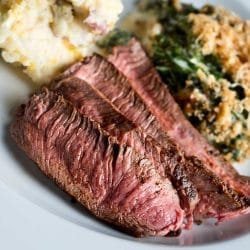
Pioneer Woman London Broil Recipe
Whether you’re hosting a weeknight family dinner or a special occasion feast, Pioneer Woman’s London Broil Recipe is the clear winner, thanks to its low price point, ease of preparation, and generous return on investment in the form of soft, juicy meat.
Ingredients
London broil
- 1 ½ pounds flank steak
- ½ cup olive oil
- ⅓ cup reduced-sodium soy sauce
- ¼ cup balsamic vinegar
- 2 tablespoons lemon juice
- 2 tablespoons brown sugar
- 1 ½ tablespoons Worcestershire sauce
- 1 tablespoon Dijon mustard
- 1 tablespoon each onion powder and garlic powder
- 1 teaspoon each paprika, dried oregano, dried parsley, dried basil, and pepper
- ½ teaspoon each dried thyme, dried rosemary, and salt
- ½ teaspoon red pepper flakes optional
Herb butter
- 8 tablespoons (1 stick) unsalted butter at room temperature
- 1 ½ teaspoons lemon zest
- 1 clove garlic finely minced
- 1 ½ tablespoons chopped fresh chives
- 2 tablespoons finely minced herbs pick 2-3 of your favorites (parsley, tarragon, thyme, oregano, rosemary, basil)
- ⅛ teaspoon each salt and pepper
Instructions
London broil
- To tenderize the steak, pound it with a meat mallet or the edge of a can.
- In a freezer-safe Ziploc bag, combine the marinade ingredients. 2 tablespoons are set aside for subsequent use. Seal by pressing out excess air and adding the meat. Massage the marinade into the beef with your hands through the bag.
- Marinate for at least 4 hours and up to 12 hours in the refrigerator (the longer the better). In the meantime, prepare the herb butter (instructions to follow).
- Remove the steak from the marinade and set it on a foil-lined baking sheet to rest for at least 20 minutes before cooking. Meanwhile, prepare the broiler to high (550°F) for 10 minutes.
- Broil steak for 5-7 minutes on each side (up to 8 minutes for extremely thick steak), or until an internal thermometer registers 130-135 degrees F for medium rare or 140-145 degrees F for medium. Broiling periods will vary based on the thickness of your steak, so check for doneness using a meat thermometer.
- Place the steak on a cutting board and set aside for 10 minutes before slicing. Cut the meat into strips against the grain (perpendicular to the long strands). Drizzle with the remaining marinade and serve with the herb butter.
Herb butter
- Meanwhile, prepare herb butter by combining all of the herb butter ingredients in a medium mixing dish and mashing until smooth.
- Transfer to a piece of plastic wrap and roll up the plastic wrap to make a log. Wrap the butter in plastic wrap and store it in the refrigerator until hard (approximately 1 hour) or ready to use.
Notes
- Even cooking may be achieved by pounding the meat before cooking.
- Substitute red wine vinegar for the balsamic.
- Tenderizing cuts of meat like flank steak and top rounds requires a marinade. Acid and vinegar in a marinade soften a London Broil by chemically breaking down the strong muscle fibers. An abundance of flavor is also added by marinating.
- In my opinion, 12 hours is the absolute minimum time to marinate a London Broil. This will ensure that the steak is very juicy and burst with flavor.
- To store food in the freezer, I like to use freezer-safe plastic bags like Ziploc. The steak is completely submerged in the marinade, unlike in certain other preparation methods. If you’re going to store your steak in a plastic bag, make sure to remove all of the air before you close it, and then wrap the bag up to form a snug container. Easy cleaning is another benefit of using sealable bags. If you don’t have any containers with lids, you can use glass, stainless steel, or plastic ones that are safe for food and cover them with plastic wrap.
- Swap the lemon juice with lime juice or orange juice.
- Marinades should never be reheated, not even for basting, without first being boiled to kill any bacteria. Before adding the steak to the marinade (as is done in this London Broil dish! ), save aside some of the marinades to use later for basting, drizzling, or dipping.
- Your London Broil may lose some of its juiciness if you cook it for too long. Use a meat thermometer to check for doneness and broil to 140 degrees for medium. After resting, the steak’s internal temperature can reach 145 degrees.
- Add extra red pepper flakes, maybe cayenne or chipotle chili powder.
- When a steak is seared, the fluids are drawn away from the surface and into the center as it cooks. To ensure that every bite of your steak is bursting with flavor and tenderness, give it a few minutes to rest after cooking. If you don’t give the steak time to rest, some of its fluids will leak out and be wasted when you cut into it.
Nutrition
Calories: 494kcalCarbohydrates: 9gProtein: 26gFat: 39gSaturated Fat: 14gPolyunsaturated Fat: 3gMonounsaturated Fat: 19gTrans Fat: 1gCholesterol: 108mgSodium: 664mgPotassium: 537mgFiber: 1gSugar: 6gVitamin A: 839IUVitamin C: 6mgCalcium: 56mgIron: 3mg
Tried this recipe?Let us know how it was!